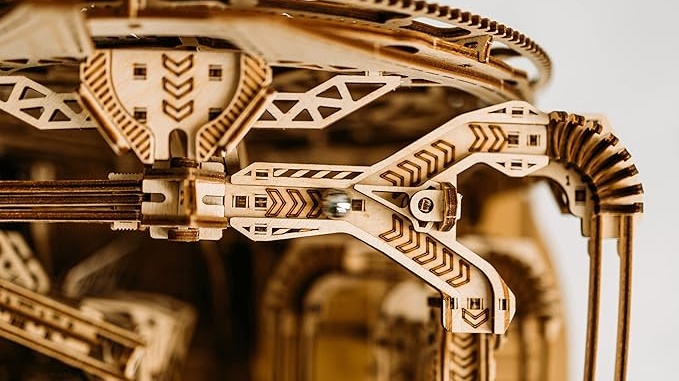
How To Add Storylines To Your Wooden Jigsaw Puzzle: A Creative Guide
Imagine a wooden jigsaw puzzle where each piece is more than a part of an image; it’s a chapter in a captivating story waiting to

The moment you lay eyes on a wooden cube puzzle, you’re not just seeing a toy, but a piece of art. These intricate puzzles are not only a test of wit but also a beautiful addition to any room.
However, like any cherished item, they require care to maintain their beauty, especially when it comes to preventing fading.
In this blog, we’ll explore effective strategies to keep your puzzle looking as splendid as the day you got it, ensuring it continues to challenge and delight.
Before diving into the solutions, it’s crucial to grasp why wooden cube puzzles might lose their luster over time. This understanding will equip you with the knowledge to better protect them.
Understanding the factors that contribute to the fading of wooden cube puzzles is essential. Sunlight, chemicals, and environmental conditions can all play a role in diminishing the vibrant appearance of these puzzles.
By identifying these threats, we can take informed steps to mitigate their effects and preserve the puzzles’ beauty.
The biggest culprit behind fading puzzles is sunlight. The UV rays can bleach the vibrant colors of your puzzle, leaving it dull and lifeless.

Ensuring your puzzle is displayed away from direct sunlight can greatly prolong its color life. Finding a spot in your home that receives indirect sunlight is key.
You might consider placing your puzzle in a room with north-facing windows, where it can enjoy soft, natural light without the damaging effects of direct sun exposure.
UV-filtering window films are also an excellent option for reducing the amount of harmful UV light that enters the room.
Certain chemicals and cleaning agents can be harsh on wooden puzzles. Using the wrong products might strip away colors and damage wood, making it crucial to choose your cleaning supplies wisely.
Avoid cleaners that contain bleach or ammonia, as these can cause significant discoloration and damage to the wood.
Instead, opt for natural cleaners like diluted vinegar or soap and water, ensuring they are applied with a soft, lint-free cloth to avoid scratching the surface.
Wood is sensitive to its environment. Extreme changes in temperature and humidity can lead to fading and even warping, highlighting the importance of maintaining a stable environment for your puzzles.
To combat this, consider using a digital hygrometer to monitor the room’s humidity levels.
During dry winter months, a humidifier can add the necessary moisture to the air, while a dehumidifier can remove excess humidity in damp conditions, protecting your puzzle from the adverse effects of environmental fluctuations.
Knowing the threats is half the battle; now let’s focus on how to protect your wooden cube puzzle from fading.
Preventative measures are your best defense against fading. By strategically placing your puzzle, applying protective coatings, and adopting gentle cleaning techniques, you can significantly extend the life and beauty of your wooden cube puzzle. Let’s explore these measures in more detail.

Choosing the right spot to display your puzzle can significantly reduce exposure to harmful UV rays. A location that avoids direct sunlight and harsh lighting is ideal for preserving its colors.
Consider placing your puzzle in a part of your home that benefits from indirect sunlight or under ambient lighting.
This not only prevents fading but also enhances the visual appeal of your puzzle as part of your home decor. A bookshelf in the living room or a display case in the hallway could serve as perfect spots.
Applying a UV protective spray or varnish can shield the colors of your puzzle from fading. This barrier not only protects from sunlight but also from dust and minor scratches.
When selecting a UV protective product, choose one that’s specifically designed for wood and clear-coated to maintain the natural look of your puzzle.
Applying a thin layer every few months can help maintain its protective barrier without compromising the puzzle’s intricate details.
When it comes to cleaning your wooden cube puzzle, gentle is the way to go. A soft cloth and mild cleaner can do wonders in keeping your puzzle dust-free and vibrant without risking damage. For regular maintenance, a dry microfiber cloth is perfect for dusting off the surface.
If your puzzle needs a more thorough clean, a slightly damp cloth with a few drops of gentle soap can remove dirt without soaking the wood. Always dry the puzzle immediately after cleaning to prevent moisture damage.
Maintaining a consistent environment is key to the longevity of your puzzle. Using humidifiers or dehumidifiers to control the room’s humidity can prevent wood from reacting harshly to environmental changes.
Strive for a balance in your home’s environment by keeping the temperature and humidity levels consistent.
Smart thermostats and humidifiers can automatically adjust settings to maintain optimal conditions for your wooden cube puzzles, ensuring they remain in pristine condition year-round.
Even with best care, your wooden cube puzzle might show signs of wear. Here’s how to bring back its original glow.
Maintaining the appearance of your wooden cube puzzle requires regular attention and care.
However, if you notice signs of wear or fading, there are effective methods for restoring its shine and color. Let’s look at some ways to rejuvenate your cherished puzzle.
Frequent inspections allow you to catch any fading early, enabling more effective intervention and maintenance of your puzzle’s aesthetics.
Setting a monthly reminder to inspect your puzzle can help you identify any early signs of wear or fading.
This regular check-up allows you to address issues promptly, ensuring that your puzzle remains in top condition.
Look for any discoloration, scratches, or changes in texture that might indicate it’s time for a little TLC.
For puzzles that have lost some of their shine, a deeper clean followed by a gentle polish can restore their luster.

Make sure to use products specifically designed for wood to avoid any damage. A specialized wood cleaner can remove oils and grime that have accumulated over time.
After cleaning, applying high-quality wood polish can enhance the natural beauty of your puzzle, providing a protective layer that also repels dust. Apply polish with a soft cloth, using circular motions to ensure even coverage.
In cases where fading is significant, professional restoration might be the best option. Experts can match colors and finish bringing your puzzle back to its former glory.
If your puzzle holds sentimental value or is a collector’s item, seeking professional restoration services can be a worthwhile investment.
These experts have the skills and tools to meticulously restore your puzzle, matching the original colors and finish.
They can also provide advice on how to prevent future fading, ensuring your puzzle remains a cherished part of your collection.
In the end, keeping your wooden cube puzzle vibrant and colorful is about understanding the causes of fading and taking proactive steps to mitigate them.
From careful placement away from sunlight to the application of protective coatings and gentle cleaning techniques, these strategies can ensure your puzzle remains a lasting treasure.
Remember, a little effort goes a long way in preserving the beauty and integrity of your wooden cube puzzle, making every moment of solving it as enjoyable as the first.
Can I use regular furniture polish on my wooden cube puzzle?
No, it’s best to avoid using regular furniture polish on your wooden cube puzzle, as these products often contain harsh chemicals or silicones that can build up on the surface or even seep into the wood, potentially damaging the puzzle over time. Instead, look for natural, silicone-free wood polishes or conditioners specifically recommended for delicate wooden items.
How often should I apply UV protective coatings to my puzzle?
The frequency of applying UV protective coatings depends on the product’s instructions and the puzzle’s exposure to light. Generally, reapplying a protective coating every six to twelve months is a good rule of thumb. However, if your puzzle is in a room with a lot of natural light, you might consider applying it more frequently to ensure continuous protection.
Is it safe to display my wooden cube puzzle near a window with blinds or curtains?
While blinds or curtains can significantly reduce UV exposure, they may not block all harmful rays, especially during peak sunlight hours. It’s safer to display your puzzle away from direct sunlight altogether or use UV-filtering window films in addition to blinds or curtains for added protection.
What should I do if my wooden cube puzzle gets wet?
If your puzzle gets wet, it’s important to dry it immediately and thoroughly. Gently blot the moisture with a soft, dry cloth, and then allow the puzzle to air dry in a well-ventilated area away from direct heat sources. Do not use a hair dryer or other heating tool, as this can cause wood to warp or crack. If water damage occurs, consult a professional restorer for advice on repair and restoration.
How can I test if the environmental humidity is appropriate for my puzzle?
An inexpensive digital hygrometer can accurately measure the humidity level in your home. For wooden cube puzzles, maintaining a relative humidity (RH) level between 40% and 60% is ideal. If your home’s RH levels fall outside this range, consider using a humidifier or dehumidifier to adjust the moisture in the air and create a more suitable environment for your puzzle.


Imagine a wooden jigsaw puzzle where each piece is more than a part of an image; it’s a chapter in a captivating story waiting to

When choosing the right puzzle box(wooden puzzle boxes or paper one) for your toddler, it’s essential to consider the materials’ properties and how they align

Embark on a journey to unravel the nuanced distinctions between two beloved genres of puzzles: plain wooden puzzles and 3d wooden puzzles. In this comprehensive

Imagine your wooden jigsaw puzzle not just as a piece to be solved but as an interactive journey that engages all your senses. This guide

Imagine a wooden jigsaw puzzle where each piece is more than a part of an image; it’s a chapter in a captivating story waiting to

When choosing the right puzzle box(wooden puzzle boxes or paper one) for your toddler, it’s essential to consider the materials’ properties and how they align

Embark on a journey to unravel the nuanced distinctions between two beloved genres of puzzles: plain wooden puzzles and 3d wooden puzzles. In this comprehensive

Imagine your wooden jigsaw puzzle not just as a piece to be solved but as an interactive journey that engages all your senses. This guide
Copyright © 2024 woodcraft3dpuzzles. All Rights Reserved.